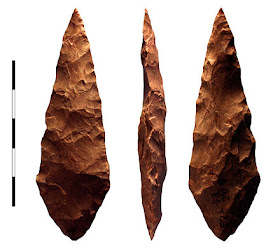Stone was used by early man to make durable, sharp tools to cut, scrape, chop, pierce, pound, and bore. These tools demonstrated his cognitive ability to plan, reason, and communicate skills. There is evidence that on the southern tip of Africa, at Pinnacle Point, early man used fire to alter stone - a technic known as HEAT TREATING. This treatment altered the poor quality properties of silcrete - making it glossier, easier to shape and flake, sharper. Silcrete is a conglomerate formed when surface sand and gravel are cemented by dissolved silica, resembling quartzite. The picture below shows an unheated piece of silcrete, next to a heat treated flaked tool. The artifacts collected date back 72,000 years and shows fire being commanded in a sophisticated manner. Before this discovery, heat treating was thought to have originated in Europe around 25,000 years ago. Researchers replicated the heat treating process by burying spalls of silcrete beneath a fire pit. The resulting process changed the properties of the mineral turning it reddish in color, glossier, and easier to flake. Heat treating is used today by modern flintknappers to alter difficult stone, using kilns and ovens to control the level of heat and duration.




No comments:
Post a Comment